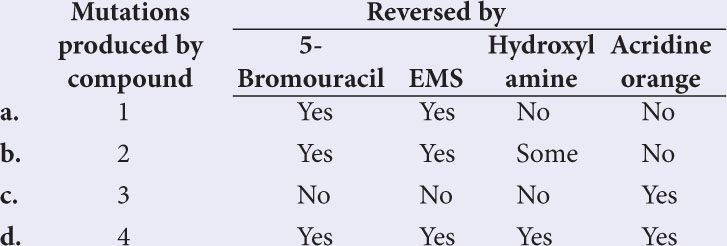Answers to Concept Checks
- 1. c
- 2. A reverse mutation restores the original phenotype by changing the DNA sequence back to the wild-type sequence. A suppressor mutation restores the phenotype by causing an additional change in the DNA at a site that is different from that of the original mutation.
- 3. The frequency with which changes arise in DNA, how often these changes are repaired by DNA-repair mechanisms, and our ability to detect the mutation
- 4. c
- 5. In transposition, staggered cuts are made in DNA and the transposable element inserts into the cut. Later, replication of the single-stranded pieces of DNA creates short flanking direct repeats on either side of the inserted transposable element.
- 6. Transposition often results in mutations because the transposable element inserts into a gene, destroying its function. Chromosome rearrangements arise because transposition includes the breaking and exchange of DNA sequences. Additionally, multiple copies of a transposable element may undergo homologous recombination, producing chromosome rearrangements.
- 7. d
- 8. a
- 9. d
- 10. Direct-repair mechanisms return an altered base to its correct structure without removing and replacing nucleotides. Mismatch repair and base-excision repair remove and replace nucleotides.
- 11. Changes in DNA structure may not undergo repair in people with defects in DNA-repair mechanisms. Consequently, increased numbers of mutations occur at all genes, including those that predispose to cancer. This observation indicates that cancer arises from mutations in DNA.
528
WORKED PROBLEMS
Problem 1
The mutations produced by the following compounds are reversed by the substances shown. What conclusions can you make about the nature of the mutations originally produced by these compounds?

|
Solution Strategy
What information is required in your answer to the problem?
Conclusions you can make about the types of mutations produced by each compound based on the substances that reverse the mutations.
What information is provided to solve the problem?
Which substances reverse the mutations produced by each compound.
For help with this problem, review:
Chemically Induced Mutations in Section 18.2.
Solution Steps
- a. Mutations produced by compound 1 are reversed by 5-bromouracil, which produces both A · T → G · C and G · C → A · T transitions, which tells us that compound 1 produces single-base substitutions that may include the generation of either A · T or G · C pairs. The mutations produced by compound 1 are also reversed by EMS, which, like 5-bromouracil, produces both A · T → G · C and G · C → A · T transitions; so no additional information is provided here. Hydroxylamine does not reverse the mutations produced by compound 1. Because hydroxylamine produces only C · G → T · A transitions, we know that compound 1 does not generate C · G base pairs. Acridine orange, an intercalating agent that produces frameshift mutations, also does not reverse the mutations, revealing that compound 1 produces only single-base-pair substitutions, not insertions or deletions. In summary, compound 1 appears to cause single-base substitutions that generate T · A but not G · C base pairs.
Hint: The ability of various compounds to produce reverse mutations reveals important information about the nature of the original mutation.
- b. Compound 2 generates mutations that are reversed by 5-bromouracil and EMS, indicating that it may produce G · C or A · T base pairs. Some of these mutations are reversed by hydroxylamine, which produces only C · G → T · A transitions, indicating that some of the mutations produced by compound 2 are C · G base pairs. None of the mutations are reversed by acridine orange; so compound 2 does not induce insertions or deletions. In summary, compound 2 produces single-base substitutions that generate both G · C and A · T base pairs.
- c. Compound 3 produces mutations that are reversed only by acridine orange; so compound 3 appears to produce only insertions and deletions.
- d. Compound 4 is reversed by 5 bromouracil, EMS, hydroxylamine, and acridine orange, indicating that this compound produces single-base substitutions, which include G · C and A · T base pairs, insertions, and deletions.
Problem 2
Certain repeated sequences in eukaryotes are flanked by short direct repeats, suggesting that they originated as transposable elements. These same sequences lack introns and possess a string of thymine nucleotides at one ends. Have these elements transposed through DNA or RNA sequences? Explain your reasoning.
529
Solution Strategy
What information is required in your answer to the problem?
Whether the transposable elements transpose through a DNA or an RNA intermediate and why you made this conclusion.
What information is provided to solve the problem?
 The element is flanked by short direct repeats.
The element is flanked by short direct repeats. The element lacks introns and has a string of Ts at one end.
The element lacks introns and has a string of Ts at one end.
For help with this problem, review:
Transposition in Section 18.4.
Solution Steps
The absence of introns and the string of thymine nucleotides (which would be complementary to adenine nucleotides in RNA) at one end are characteristics of processed RNA. These similarities to RNA suggest that the element was originally transcribed into mRNA, processed to remove the introns and add a poly(A) tail, and then reverse transcribed into a complementary DNA that was inserted into the chromosome.
Recall: PremRNAs in eukaryotes are processed: a 5′ cap is added, introns are removed and a 3′ poly(A) tail is added.